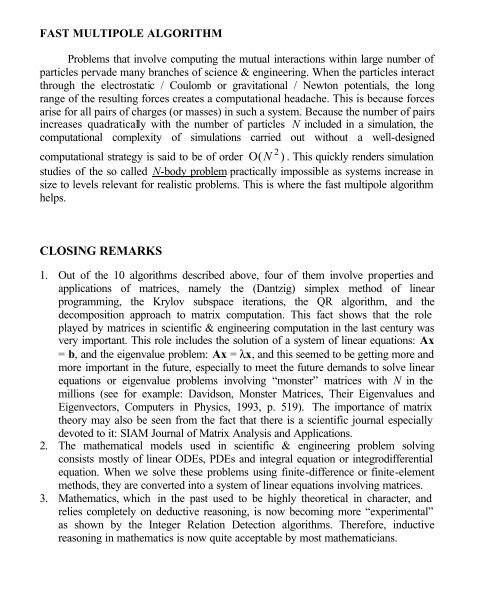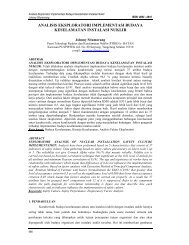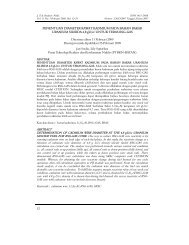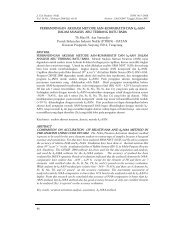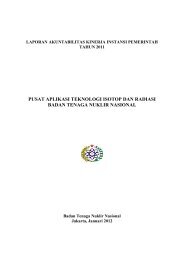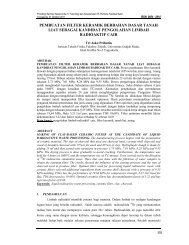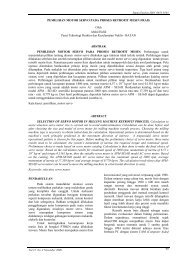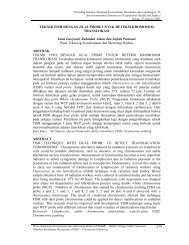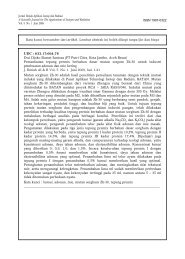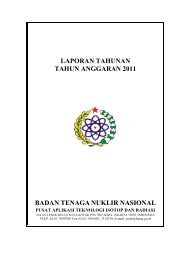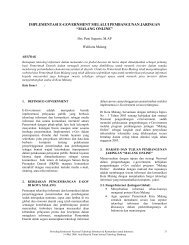THE TOP 10 ALGORITHMS OF THE 20TH CENTURY M ... - Batan
THE TOP 10 ALGORITHMS OF THE 20TH CENTURY M ... - Batan
THE TOP 10 ALGORITHMS OF THE 20TH CENTURY M ... - Batan
You also want an ePaper? Increase the reach of your titles
YUMPU automatically turns print PDFs into web optimized ePapers that Google loves.
FAST MULTIPOLE ALGORITHM<br />
Problems that involve computing the mutual interactions within large number of<br />
particles pervade many branches of science & engineering. When the particles interact<br />
through the electrostatic / Coulomb or gravitational / Newton potentials, the long<br />
range of the resulting forces creates a computational headache. This is because forces<br />
arise for all pairs of charges (or masses) in such a system. Because the number of pairs<br />
increases quadratically with the number of particles N included in a simulation, the<br />
computational complexity of simulations carried out without a well-designed<br />
computational strategy is said to be of order ( N ) . This quickly renders simulation<br />
studies of the so called N-body problem practically impossible as systems increase in<br />
size to levels relevant for realistic problems. This is where the fast multipole algorithm<br />
helps.<br />
CLOSING REMARKS<br />
O 2<br />
1. Out of the <strong>10</strong> algorithms described above, four of them involve properties and<br />
applications of matrices, namely the (Dantzig) simplex method of linear<br />
programming, the Krylov subspace iterations, the QR algorithm, and the<br />
decomposition approach to matrix computation. This fact shows that the role<br />
played by matrices in scientific & engineering computation in the last century was<br />
very important. This role includes the solution of a system of linear equations: Ax<br />
= b, and the eigenvalue problem: Ax = λx, and this seemed to be getting more and<br />
more important in the future, especially to meet the future demands to solve linear<br />
equations or eigenvalue problems involving “monster” matrices with N in the<br />
millions (see for example: Davidson, Monster Matrices, Their Eigenvalues and<br />
Eigenvectors, Computers in Physics, 1993, p. 519). The importance of matrix<br />
theory may also be seen from the fact that there is a scientific journal especially<br />
devoted to it: SIAM Journal of Matrix Analysis and Applications.<br />
2. The mathematical models used in scientific & engineering problem solving<br />
consists mostly of linear ODEs, PDEs and integral equation or integrodifferential<br />
equation. When we solve these problems using finite-difference or finite-element<br />
methods, they are converted into a system of linear equations involving matrices.<br />
3. Mathematics, which in the past used to be highly theoretical in character, and<br />
relies completely on deductive reasoning, is now becoming more “experimental”<br />
as shown by the Integer Relation Detection algorithms. Therefore, inductive<br />
reasoning in mathematics is now quite acceptable by most mathematicians.


